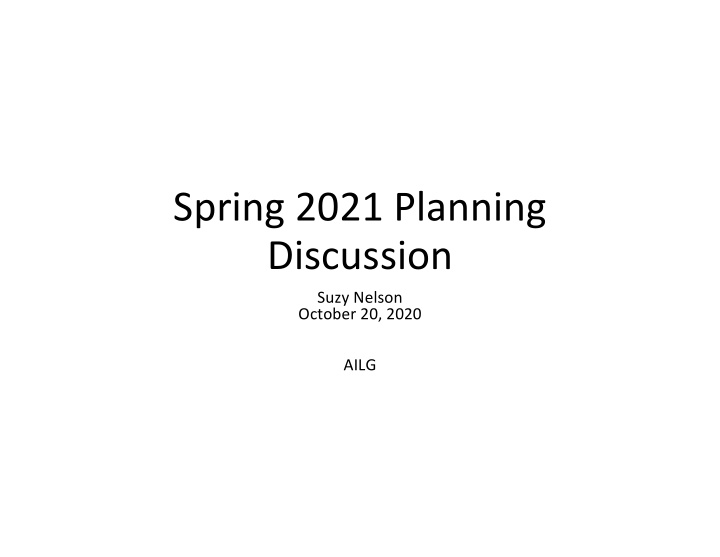



Spring 2021 Planning Discussion Suzy Nelson October 20, 2020 AILG
Spring 2021 questions being considered ● Can MIT safely bring 1st, 2nd and 3rd year students (and SHARP and graduate students ) to MIT in the spring? ● What are the major hurdles/ risks? ● What could we do (and what will be required) to overcome or mitigate these major risks?
Guiding principles and goals • Prioritize the safety of our community and our neighbors • Aspire to invite everyone to one semester on campus • Take advantage of new housing capacity available in spring • Build on experience operating during a pandemic thus far • Deliver an academic and student experience that is as excellent as possible • Support the mental health and well-being of our community members
Our plans for fall... Bringing some students back to campus (a measured approach) • Leadership worked collaboratively with the community to determine options • Prioritizing UG seniors as well as others who need to be on campus • Allowing most grad students + researchers to be on campus • Modifying policies and adapting services • Significantly reducing capacity on campus 4
How things are going... Campus life 780 undergraduates (24% occupancy); 1,334 grad students (58% occupancy) • Student Housing Assistance Review Process (SHARP): 308 • ~1,250 meals served daily in all UG residences and W20’s Lobdell Dining Hall • Expedited COD Process: 185 (10/18/20) • Number of students positive/isolating: 19 • Teaching and learning Strong enrollments (esp. class of 2024); less than 5% took a leave, and 6-7% of UGs took gap year • Majority of courses remote, some with in-person and lab elements; emphasis on collaboration • Testing and compliance 4,000+ tests per day; low wait times; ~95% compliance ( 100,000 tests, over 8 weeks, .05% • positive rate) 5
Fall 2020 lessons learned ● Measured approach is working ○ Policies, procedures, monitoring compliance, implementation & decision making ○ Research operations & in-person (e.g., classes, UROPs) conducted concurrently ○ Rigorous testing, tracing, and isolating , effective space management, access control, policy implementation ● Managing ~7000 students living on- and off-campus (2200 + 5000), including 2600 off-campus graduate students accessing campus for research + classes ○ Low transmission on campus ○ Time consuming: monitoring compliance, COD response, and student support ● Learning from peers: strategies for supporting larger cohorts of students
Fall 2020 lessons learned (continued) ● Diminished student experience for on- and off-campus students Mental health and isolation is a concern o Students want to be together with friends o Pods: wellbeing benefits; have introduced some risks when intermixing o § > 6 in a Pod “family or friend-group” § Relax strictures (e.g., face covering, physical distancing) ● Improving the on-campus student experience In-person instruction, UROPs, experiential learning opportunities o Making the outdoor campus better (e.g., lighting, seating, heat, music) o Spaces for “safe” gatherings (although they increase safety risks) o
Spring 2021 Housing Options (anticipated need = 3000) Option 1: Housing 1 per room, using FSILGs, No Site 4 for UG (67% in on-campus halls) = 3007 students Option 2: Housing with 2 per room, No FSILGs, UGs in Site 4 (85% in on-campus halls) = 3052 students Option 3: Facility condition adjustment, 2 per room, No FSILGs, pod lounges, UGs in Site 4 & Eastgate (68% in on- campus halls) = 2630 students
De-risking winter ● Academic calendar will include a delay of semester start + more fully-remote time in the beginning (being finalized by APART) ● Considerations: o Begin 2 weeks later o 62 Teaching days o 3 Reading days o 6 break days Holidays / Break Days Registration Days o 2 (4 day weekends) First/Last Day of Classes Add / Drop Date o Commencement in June Remote Monday Classes on Tuesday Final Exams Grades due CAP/GAP meetings 9 Commencement Day(s)
Recommendations & possible approaches Balancing safety/ Residential density/ Quality of experience • • Invite three undergrad classes, + SHARP process, & grads to live on campus • Operate similar to Fall 2020 (quarantine week, strong testing, etc.) • Preference: Limit on-campus undergraduate residential population ~2630 • Continue off-campus graduate student access to campus for research or class • Increase in-person learning opportunities • Invest in staffing and infrastructure (IT, student support, monitoring) Considerations for managing residential density of ~3000 • • Increase residential density beyond preferred density of ~2630 • Limited opening of FSILGs, with FSILG students granted access to campus? • Wastewater testing would provide increased comfort level • Grant access to campus for students residing in apartments off-campus?
Discussion questions • What has your experience been this term? What challenges have you faced? • Would you prefer to stay closed, supported by MIT, or open? Pros/Cons? • What challenges do you anticipate facing, and how will you address them?
Background 12
Testing compliance is currently > 95% which puts us in a strong position (and working to improve it) https://idss.mit.edu/vignette/rules-of-thumb-for-reopening-2
Recommend
More recommend